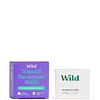What's inside
What's inside
 Key Ingredients
Key Ingredients

No key ingredients
 Benefits
Benefits

 Concerns
Concerns

 Ingredients Side-by-side
Ingredients Side-by-side

Water
Skin ConditioningOryza Sativa Starch
AbsorbentZinc Oxide
Cosmetic ColorantLactose
HumectantWhey Protein
Skin ConditioningBifida Ferment Lysate
Skin ConditioningCapryloyl Glycine
CleansingEthylhexylglycerin
Skin ConditioningCocoyl Proline
Skin ConditioningSodium Acrylate/Sodium Acryloyldimethyl Taurate Copolymer
Emulsion StabilisingIsohexadecane
EmollientPolysorbate 80
EmulsifyingMaltodextrin
AbsorbentHyssopus Officinalis Extract
MaskingEugenia Caryophyllus Flower Oil
MaskingPhenoxyethanol
PreservativeParfum
MaskingHydroxyethylcellulose
Emulsion StabilisingAllantoin
Skin ConditioningWater, Oryza Sativa Starch, Zinc Oxide, Lactose, Whey Protein, Bifida Ferment Lysate, Capryloyl Glycine, Ethylhexylglycerin, Cocoyl Proline, Sodium Acrylate/Sodium Acryloyldimethyl Taurate Copolymer, Isohexadecane, Polysorbate 80, Maltodextrin, Hyssopus Officinalis Extract, Eugenia Caryophyllus Flower Oil, Phenoxyethanol, Parfum, Hydroxyethylcellulose, Allantoin
Caprylic/Capric Triglyceride
MaskingTapioca Starch
Stearyl Alcohol
EmollientSodium Bicarbonate
AbrasiveTriethyl Citrate
MaskingHelianthus Annuus Seed Cera
EmollientCocos Nucifera Oil
MaskingParfum
MaskingButyrospermum Parkii Butter
Skin ConditioningTheobroma Cacao Seed Butter
EmollientMagnesium Hydroxide
AbsorbentZinc Ricinoleate
Tocopheryl Acetate
AntioxidantHexyl Cinnamal
PerfumingHelianthus Annuus Seed Oil
EmollientBenzyl Salicylate
PerfumingCoumarin
PerfumingTocopherol
AntioxidantCaprylic/Capric Triglyceride, Tapioca Starch, Stearyl Alcohol, Sodium Bicarbonate, Triethyl Citrate, Helianthus Annuus Seed Cera, Cocos Nucifera Oil, Parfum, Butyrospermum Parkii Butter, Theobroma Cacao Seed Butter, Magnesium Hydroxide, Zinc Ricinoleate, Tocopheryl Acetate, Hexyl Cinnamal, Helianthus Annuus Seed Oil, Benzyl Salicylate, Coumarin, Tocopherol
 Reviews
Reviews

Alternatives
Ingredients Explained
These ingredients are found in both products.
Ingredients higher up in an ingredient list are typically present in a larger amount.
Parfum is a catch-all term for an ingredient or more that is used to give a scent to products.
Also called "fragrance", this ingredient can be a blend of hundreds of chemicals or plant oils. This means every product with "fragrance" or "parfum" in the ingredients list is a different mixture.
For instance, Habanolide is a proprietary trade name for a specific aroma chemical. When used as a fragrance ingredient in cosmetics, most aroma chemicals fall under the broad labeling category of “FRAGRANCE” or “PARFUM” according to EU and US regulations.
The term 'parfum' or 'fragrance' is not regulated in many countries. In many cases, it is up to the brand to define this term.
For instance, many brands choose to label themselves as "fragrance-free" because they are not using synthetic fragrances. However, their products may still contain ingredients such as essential oils that are considered a fragrance by INCI standards.
One example is Calendula flower extract. Calendula is an essential oil that still imparts a scent or 'fragrance'.
Depending on the blend, the ingredients in the mixture can cause allergies and sensitivities on the skin. Some ingredients that are known EU allergens include linalool and citronellol.
Parfum can also be used to mask or cover an unpleasant scent.
The bottom line is: not all fragrances/parfum/ingredients are created equally. If you are worried about fragrances, we recommend taking a closer look at an ingredient. And of course, we always recommend speaking with a professional.
Learn more about Parfum